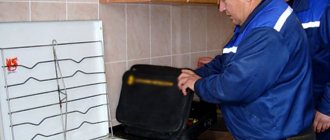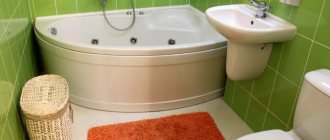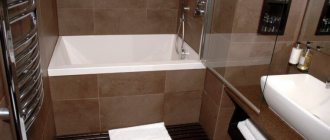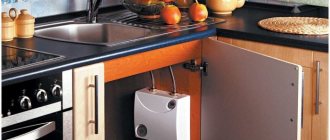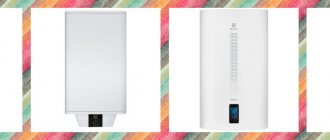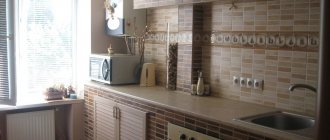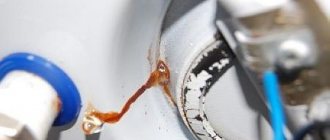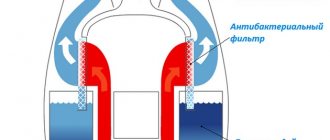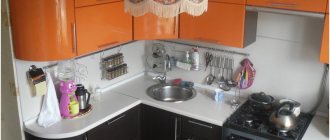Non-pressure water heater for an apartment. Bathroom. Above the sink.
© home-comfort / Electrolux Smartfix 2.0 TS
Example:
This Electrolux Smartfix instantaneous water heater is connected to the water supply (cold water).
Its advantages:
- ultra-compact to fit into a small apartment
- has overheating protection
- productivity 2-4 liters per minute
The kit includes a shower head or faucet, or both a faucet and a shower head. You can choose what suits you best for your home.
Installation
Before installation, you must carefully study the instructions to know how to properly connect the heater to the water supply network.
Having determined the location of the boiler, it is necessary to mark the points for the anchor bolts. The height of the mounting line is determined by fitting the boiler. Draw a horizontal line with a marker or pencil. The distance between the mounting points is measured between the holes on the bracket on the back of the boiler.
If the wall is tiled, then first drill holes into the concrete without using impact drilling mode, and moisten the drilling site with water. Then holes are drilled in the main wall where the bolts are inserted. Having secured the anchors, the storage device is hung on them.
Before connecting to the water supply, you need to study the diagram again. In a new apartment, when planning the internal water supply network, connections for connecting the boiler can be immediately provided, to which it is connected using flexible hoses.
Tankless water heater for shower. Bathroom. Between sink and shower
This type of water heater can easily supply hot water to both the bathroom and the kitchen at the same time.
The advantages of such a water heater:
- It supplies water to several water points at once. This means that you simultaneously get hot water both in the bathroom and in the kitchen, that is, you can take a shower and wash dishes in the kitchen, for example
- capacity 12 liters per minute
- scale protection
- overheat protection
- inlet and outlet water temperature sensors
* Suitable for both home and offices, industrial premises, as well as small businesses, including Horeca, fitness clubs and saunas.
Choose a place so that it is convenient to connect it to the central water supply
Bathroom. Hidden under the sink on the side. Pressure water heater.
The instantaneous water heater itself is very compact, which means it is perfect for a small apartment. Installation is also not very difficult, but it is better to entrust it to a professional.
© home-comfort / AQUATRONIC Digital Series
Example:
The photo shows a compact instantaneous water heater from the Aquatronic Digital (Electrolux) series.
Its main advantages:
electronic control (more precise control of water temperature), scale protection thanks to innovative PullSten vibration technology, protection against switching on without water, overheating protection, dust and moisture protection class: IPX4
Tankless water heaters can be hidden if you don't want them to be noticeable. Here are the possible options:
Bathroom. Instantaneous water heater hidden in a cabinet.
For more reliable fastening, the walls on which it is installed must be strong, even despite their low weight. The walls must also be level to ensure proper installation of the device.
- Suitable:
brick, concrete and wood.
- Not suitable:
from plasterboard.
You can hide it in the kitchen in the same way.
It is very important that it is installed in a place convenient for its operation. It should be convenient for you to turn it on and regulate the temperature. It can be attached either to the wall or to the side of the cabinet.
Important:
Installation must be carried out by a professional technician and always according to the instructions.
Instantaneous water heater in the form factor of a mixer tap for an apartment. Kitchen.
Instantaneous water heaters in the form factor of a mixer tap
are pressure, but serve only one point with hot water.
Main advantage
is the ease of installation - we fix it in place of a regular mixer, connect the cold water inlet and plug the device into an outlet - ready! The whole process takes a few minutes.
At the same time, design solutions
in the production of such models they help to fit flow-throughs of this type into any interior.
© Easy-comfort / Zanussi SmartTap
Example:
the model you see in the photo is called Zanussi SmartTap. Such instantaneous water heaters are unique both in design and in their functionality and implementation of technologies for maximum safe use.
These water heaters fit perfectly into any design, instantly heat water and are easy to install on any horizontal surface, be it a sink or countertop.
Here are some advantages of this model:
- the presence of a flexible hose-spout
- presence of heating indication
- temperature adjustment
- dust and moisture protection class: IPX4
- overheat protection
- protection against switching on without water
- productivity 1.3 l/min.
Perfect for home use.
Designs for masking the boiler
At the initial stage, it should be taken into account that manufacturers of water heaters provide at least an average level of decorative value for the body of the water heater, meaning its installation on walls or on the floor without additional camouflage.
Thus, choosing a ready-made cabinet for a bath, hallway, kitchen or corridor, inside which a water heater will ideally fit, without gaps and dismantling some shelves, is a very difficult task. Since the owner does not yet have either a cabinet or a boiler, he runs around the shops and compares their mutual dimensions until they are completely compatible.
The exception is “under the sink”, “under the sink” boilers installed in floor cabinets. However, they are all low-power, since it is physically impossible to stuff large-volume tanks into small-sized furniture.
Therefore, structures inside which a storage water heater can be hidden are usually built by a home craftsman himself.
Box
A box is a structure that protrudes outward relative to the plane of the wall. Roughly speaking, this is a cabinet made of gypsum plasterboard sheets screwed onto a frame made of galvanized profile. Unlike a cabinet, the structure is stationary and non-removable. Instead of a door for access to the interior, an inspection hatch is used - hinged, sliding, push-button, removable.
The box manufacturing technology is as follows:
- fastening, piping the water heater (this will be problematic to do later);
- fixing the guide profile;
Attaching the starting profile. - installation of a rack profile;
- frame assembly;
Frame installation - installation of an inspection hatch;
- covering the frame with plasterboard;
Fastening gypsum board sheets. - finishing of external surfaces with tiles.
The box can be vertical from the ceiling to the floor or half the length of the wall, horizontal, stepped, of a complex configuration, depending on where the water supply and boiler are located.
Niche behind the toilet
Unlike the previous option, the niche is sewn up with one panel; there are no sides.
Material consumption is reduced and the labor intensity of the process is reduced.
A popular way to disguise engineering systems and water heaters in the niche behind the toilet are blinds, as in the bottom photo.
Pipes may interfere with fixing the electrical appliance to the wall using standard fasteners. In this case, brackets or special fastening systems are used.
Adjustable fastening system made of profile perforated pipe with brackets.
In this case, a stepped box is used, the wall is built up only above the toilet.
Niche under the kitchen window
Step-by-step instructions for hidden installation of a storage water heater in a niche under a kitchen window are as follows:
- dismantling standard doors, shelves lining internal surfaces;
- sewerage, electrical, water supply installations;
- finishing niche surfaces;
- installation of a water heater, installation of engineering systems;
- installation of inspection hatch, sliding and swing doors, blinds.
Access to the water heater body is necessary in order to clean the tank from scale and change the anodic protection electrodes.
Mezzanine
In the standard version, the mezzanine shelf is used to store household items. In this case, the purpose of this architectural structure changes. The shelf is equipped with blinds or doors, and a storage boiler is installed on it. The sequence of operations for manufacturing a mezzanine for a water heater is as follows:
- horizontal mark on opposite walls of the corridor;
- fastening bars or profiles to walls;
- laying the shelf on profiles/bars;
Installation of the mezzanine step by step. - installation of doors or blinds;
- installation of a water heater, connection to the electrical network, water supply, sewerage.
Installation of the boiler on the mezzanine.
Attention: Only horizontal models of water heaters must be installed on the mezzanine. It is not allowed to lay vertical boilers on their sides.
Wall cabinet
The option of installing a single-circuit electric boiler in an industrially manufactured wall cabinet is the least labor-intensive, but the most costly in terms of finances. The main installation nuances are:
- the standard cabinet fasteners will not support the weight of a storage heater with a full tank of water;
- the boiler is attached directly to the wall, either through the back wall of the furniture, or after its dismantling;
- to connect to sewerage, cold water, and hot water circuits, it is best to install water sockets inside the cabinet on the wall of the room;
- To connect to a 220 V network, an electrical outlet with grounding is inserted into the cabinet in the same way.
Plastic and composite pipes are always cheaper than long flexible metal hoses and last several times longer.
Closet
The interior solution “boiler inside a wardrobe” is optimal for a corridor or hallway. It is in these rooms that such furniture is used most often, and they are located in close proximity to the bathroom and kitchen. You can connect to the sewer/water supply through the wall. To do this, the back or side wall of the wardrobe must be the enclosing structure of a bath, toilet or kitchen.
The design of the built-in wardrobe is extremely simple - the doors move from ceiling to floor on rollers along guides, there are no side or rear walls. The upper part of one furniture compartment is allocated for the boiler; standard shelves for storing things are installed in the remaining space.
Floor stand
Due to the small size of bathroom cabinets and floor cabinets for kitchen sinks, it is impossible to fit a large-volume storage single-circuit electric boiler inside this furniture. Single-door cabinets accommodate a device with a maximum 30 liter tank, double-door cabinets - with a 80 liter tank.
Water heaters are installed on a cabinet shelf or attached to the wall of the room, and may have legs.
What about installing storage water heaters?
Large storage water heaters require more space. For two people you need a water heater with a volume of 50 liters, and for three or four people - 80-100 liters.
Most often, a storage water heater is installed in the bathroom under the ceiling in a horizontal or vertical position. Here's what they might look like in your home:
Bathroom. Vertical wall installation.
If you are offered the service of an installation specialist, it is better to consider this option.
Bathroom and toilet. Horizontal wall installation.
Toilet. Vertical wall installation.
Work order
The general algorithm for masking plumbing communications is as follows:
- Inspection of the premises, making a decision on how to close the opening.
- Drawing up a sketch and diagram, carrying out calculations of building materials, checking tools.
- Preparing the box for fastening the cladding and fasteners.
- Manufacturing of the basic structure.
- Finishing of the building.
Upon completion of installation, the performance of the screen is checked and minor deficiencies are eliminated.
Is it possible to hide a storage water heater?
If such an idea appears, then why not think about it. There are different options, but you need to choose the one that suits your interior. Most often they try to hide a large storage boiler.
Here are a few approximately, because small flow-through ones can be perfectly hidden (as you have already seen above) in a cabinet in the kitchen or bathroom:
A tile door, false wall or cabinet hides the boiler
Here are a couple more options:
BUT:
If the water heater has a flat shape, it looks modern and will decorate your interior.
As you can see, flow-through heaters are easier in this regard. How do they differ from accumulative ones? What is best for a small apartment?
Cheap DIY toilet finishing with broken tiles
Craftsmen are reluctant to take on small-scale repairs – in particular, this applies to toilets. This bathroom was not only renovated with your own hands, but also in an unusual way: there were broken tiles on the walls.
I plan to hang the 80 liter flat water heater in the corner of the bathroom, not in a niche. Please advise how to close a huge water heater at eye level
Galina
- Like | 5
- Save
Galina
- Like
- Save
Which water heater to choose
Instantaneous water heater
It heats up the water as soon as you turn on the tap or shower.
There is a heating element inside - it instantly heats cold water when it passes through it. As soon as the tap was opened, hot water started flowing.
Flow heaters are divided into two types:
- Gravity
– Suitable for heating water at one point. This could be either a faucet in the bathroom or in the kitchen, for example. There are low-power models (up to 3.5 kW), which are plugged into a regular outlet, as well as high-power devices up to 6.5 kW.
- Pressure
- These are powerful water heaters that supply you with hot water to both the kitchen and the bathroom at the same time. Such a device requires a lot of power, which means it needs powerful electrical wiring. If installed in an old house, then most likely you will need to run a separate cable from the panel.
- Pressure water heaters in mixer form factor
They provide hot water to one point, but at the same time the water is supplied to them under pressure.
Storage water heater
Here, too, the name speaks for itself - the device accumulates water in a tank, heats it, and supplies the already heated water to the tap or shower.
Useful tips
The simplest option for installation is an electric boiler. This type of water heater may have 1 or 2 heating elements. It is better to choose a double one: since one of the heating elements may fail, then the second one will replace it
If desired, one can be disabled to save money. To increase the performance of the boiler, it is recommended to connect recirculation. If you purchase a large-volume water heater (200 liters), then take into account that the water in it takes a long time to heat up (up to 6 hours). And installation of the unit is possible only on the floor (installation on the wall is excluded).
Each person consumes up to 20 liters of water per day
Based on this amount when determining the required tank volume of the device. In the case of using an electric heating element, grounding is done.
It is reasonable to foresee the possibility of disconnecting the indirect boiler from the gas boiler and install special taps for this.
In general, installing a water heating system does not require much experience. The main thing is to take into account the type and method of connection to the power source. It is also necessary to carefully consider the project and take into account access to electrical lines, water supply, and drainage. And if you have to connect the unit to alternative power sources (or a gas water heater), then be sure to consult or entrust the complete connection of the water heater to a specialist.
How to choose a water heater
Have you already decided which water heater is right for you?
We immediately note:
A instantaneous water heater immediately supplies hot water, and a storage water heater supplies it after a while. At the same time, all modern models of water heaters from reliable manufacturers are safe.
- Instantaneous water heaters
They are usually installed above or below the sink. They take up very little space. You can install several of these heaters - one in the kitchen, another in the bathroom, for example.
- If there is often no hot water in the apartment
, then you should take a closer look at a powerful
pressure
water heater.
For a shower
, it is better to use it so that the water pressure is good. They can supply you with hot water for a long time, but their connection must be done by a professional electrician. - For dachas, storage water heaters are usually used
, since they connect to a regular outlet and do not require more powerful electrical wiring.
- Fill the bathtub?
If both instantaneous and storage water heaters are enough for your shower, then filling the bathtub will be a rather expensive procedure - you will not only spend a lot of water, but also a lot of electricity.
Important:
- If installed near a water point, it is very important that your instantaneous water heater has a degree of protection of at least IPX4.
- Have the instantaneous heater connected to a qualified technician.
The easiest way out of roller shutters
The fastest way to solve the problem of hiding the sewerage is with the help of roller shutters. This design maximizes access to the pipes, while there are no doors cluttering the space. Hanging blinds requires no experience, and beautiful curtains do not require any additional finishing.
Plumbing roller shutters are not only beautiful, but also practical
In response to the increased demand, manufacturers produce special sanitary roller shutters, endowing them with noise-insulating and heat-saving properties. If desired, it is easy to choose a color that harmonizes with the decoration of the entire room.
Methods for installing water pipes
Pipes that are visible in the bathroom can make an unpleasant impression and spoil the external impression. To solve this problem, various technologies are used to mask the water supply.
Before choosing one of the methods, you should familiarize yourself with the advantages and disadvantages of each.
Open gasket
Open pipes are mounted along the walls or above the floor, attaching them using special holders. This will not improve the design of the bathroom, but it will provide a number of other advantages. Installation does not require complex work, and the ability to inspect the water supply will help to detect and eliminate leaks in time. The cost of open installation is low.
Plastic pipes can be damaged. This is one of the reasons why installation is carried out in places where the likelihood of mechanical impact on the pipes is minimized. The installation of protective boxes will help reduce the possibility of damage and improve the design.
These designs in the bathroom are easy to assemble with your own hands from plastic panels or waterproof plasterboard. Also, water supply communications are hidden behind false walls or roller shutters. The choice of camouflage is influenced by the design features of the bathroom and the wishes of the owners.
Bathrooms constantly maintain high humidity, which contributes to the appearance of rust on steel elements. Even painting metal components and parts does not slow down the corrosion process. If metal products are covered with a box or something else, the moisture concentration around them will increase several times. Therefore, it is not recommended to cover steel pipes.
General recommendations
The advantages of installing a water heating device with your own hands are quite tangible. This installation method allows you to significantly save money and time on hiring specialists, and helps you gain experience and skills that are indispensable for independent maintenance or repair of equipment.
In addition to a conscious, competent choice of model and type of water heating device, you need to first resolve a number of important issues:
- ensuring unimpeded access to the water heater throughout the entire operational period;
- the wall allocated for the installation of a water heater must be able to withstand double the weight of the mounted device;
- electrical wiring is subject to diagnostics, after which its ability to withstand the load of the installed device is calculated;
- the condition of the pipeline is assessed and, if necessary, elements are replaced and “points” are identified for connecting the water heating device.
It is the simplicity of the design that ensures exceptional reliability and ease of operation of modern electric water heating equipment of any type. However, in order for the electrical wiring to withstand the standard 2.0 kW load created by the water heater, you will need to use a cable with a cross-section of 2.5 mm or more.
Self-installation of a water heating device is not too difficult, but it is necessary to take into account a number of basic nuances and requirements for the installation of equipment of this type.

